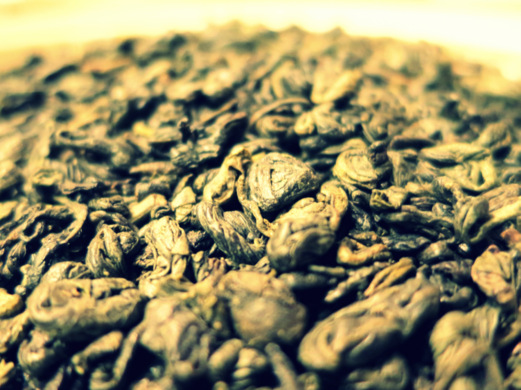May's Health Genie: Green Tea

Note: This article is not meant as a substitute for proper medical advice. Please consult with your medical practitioner before using any type of remedy, herbal or otherwise.
Dear Health Genie,
I have heard that green tea is a healthy alternative to coffee. How is green tea different from black or white tea, and with so many types of tea available, how does one go about choosing which tea to buy?
Signed,
Jasmine T.
Dear Jasmine,
Black, white, and green tea are derived from the same plant, Camellia sinensis. Tea has been used as a beverage for more than 4,000 years and is second only to water as the world’s most consumed beverage. As an alternative to coffee, green tea has the equivalent amount of caffeine to one third to one half cup of coffee (25 mg. per cup), while black tea has slightly more caffeine (35-40 mg. per cup). Green tea also contains L-theanine, a calmative chemical, which balances the effects of the caffeine.
What makes tea black, white, or green is how it is processed. Black tea leaves are withered, rolled, oxidized, and dried. The tea turns black when oxygen meets water in the tea, and oxidation occurs. Black tea is 75- 100% oxidized. White tea is allowed to dry in the sun before being processed and is only slightly oxidized. Green tea is heated after harvesting to cause it to dry more quickly than other teas. The resulting tea that is only 0-15% oxidized. As green tea is the least oxidized, it has the most powerful antioxidant properties.
Antioxidants protect the body from oxidative damage. Because green tea is so high in antioxidants, it is believed to protect the body from cancer, liver damage, and heart disease. The antioxidants benefit the body when used externally as well. Green tea can be used to take heat out of burns, such as sunburns, while reducing skin inflammation and redness. It protects skin cells and assists with the adverse effects of UV radiation exposure. See the antioxidant tea and sunburn bath recipes below.
The next consideration in deciding on a tea is taste. Each tea has its own flavor, depending on where it is grown, how it is processed and other factors. Chinese and Japanese cultures process green tea differently. In China, the tea is processed with dry heat, and the taste tends to be grassy, woody, floral or nutty. Japanese teas, on the other hand, are steamed and have a oceanic or spinach-like flavor. The bulk tea section provides you with the opportunity to buy a small amount of several teas, so you can taste test them until you find your favorite.
When preparing green tea from the bulk section, use about one heaping teaspoon of tea per cup of water. The water should not be too hot; do not use boiling water. Three aspects of the preparation should be balanced: water temperature, amount of tea, and steeping time. For instance, if you are using cool water, use more tea and steep it for longer.
You are right that there is a large variety of teas available. Hopefully this information and your taste buds will help guide you through the decision making process. I encourage you to frequent the bulk tea section at City Market and visit local tea houses, such as Dobra Tea in Burlington, Stone Leaf Teahouse in Middlebury, and Tulsi Tea Room in Montpelier to truly immerse yourself in the experience.
Green Tea with Pomegranate Juice
Recipe from Vegetariantimes.com
7 green tea bags
3 cups of pomegranate juice
½ cup orange juice
2 Tbs. Honey
1 medium orange, thinly sliced (optional)
1. Heat 6 cups of water in a large pot. Remove from heat, add tea bags, and cover for 5 minutes.
2. Remove tea bags and stir in pomegranate juice, orange juice, and honey. Transfer to a tea pot and serve by pouring into cups with floating orange slices
Sunburn Soothing Oatmeal Bath
Recipe from: mountainroseherbs.com
2 cups oatmeal
¼ cup baking soda
½ cup chamomile flowers
½ cup lavender flowers
2-4 tablespoon green tea leaves
1. Blend oatmeal in a food processor or coffee grinder until it has a powdered consistency.
2. Place all ingredients in a muslin bag or cheesecloth, tie under the faucet, and draw a lukewarm bath. Hot water will dry out and further irritate the skin. Soak for 10-15 minutes.
References:
- Frayer, Matthew. “Tea Workshop.” City Market, Burlington, VT. 3 April 2013. Guest Lecture.
- “Green Tea with Pomegranate Juice.” Vegetariantimes. Cruz Bay Publishing, Inc., 2013. Web.
- “Natural Sunburn Relief.” Mountainroseherbs. Mountain Rose Inc, 2008. Web.
- Kuhn, Merrily A. and David Winston. Herbal Supplements and Therapies: A Scientific and Traditional Approach. Philadelphia: Wolters, Kluwer Health/Lippincott, Williams and Wilkins, 2008. Print.
- Mars, Brigitte.Beauty by Nature. Summertown: Healthy Living Publications, 2006. Print.